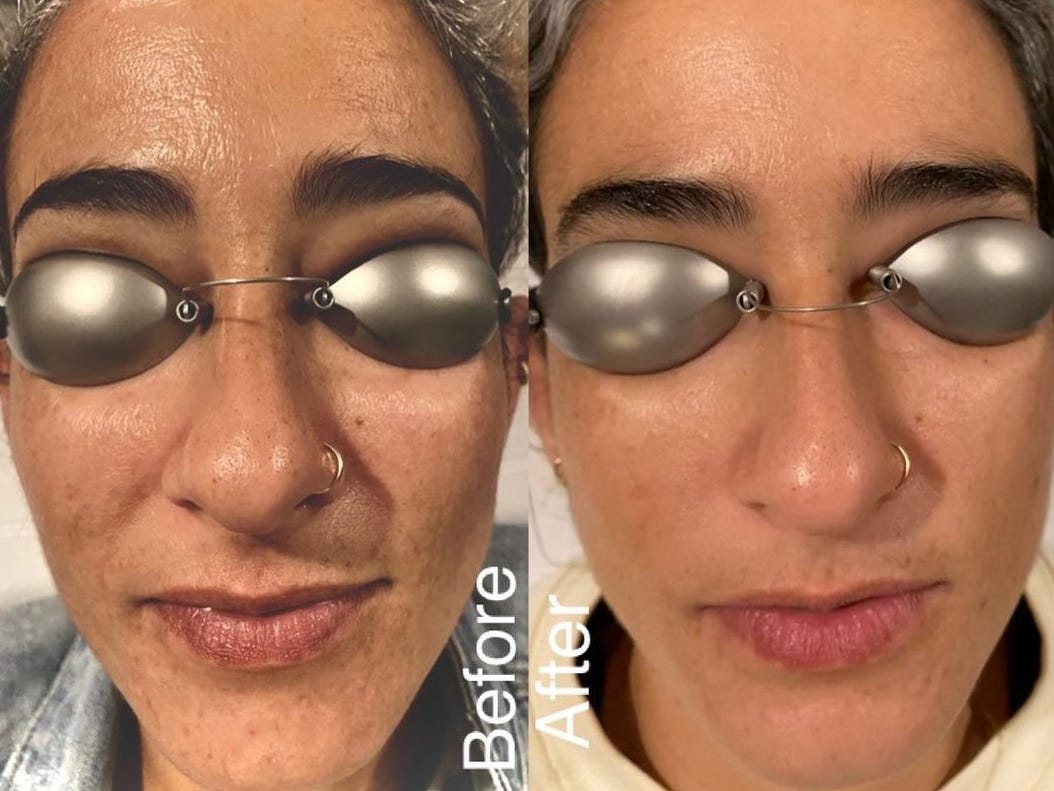
- My pregnancies left me with melasma, or darker patches of skin, all over my face.
- I tried topical creams to reduce the discolorations, but nothing really worked.
- After four sessions of LaseMD my skin is lighter, brighter, and noticeably better.
"Can you share your skin routine?" a friend asked shortly after I joined a Zoom happy hour. My friends all agreed that whatever I was doing was working, especially since they could tell the difference over a screen.
After being pregnant twice, and admittedly not taking excellent care of my skin — I only started wearing sunscreen a couple of years ago — my skin not only was showing signs of aging but was also covered in dark spots, also known as melasma. Melasma is sometimes referred to as "pregnancy mask" because pregnant people are more likely than others to experience it, and the dark spots can become more pronounced if they spend time in the sun without protection as I did.
While the dark spots were affecting my self-esteem, I'm not one for complex skin routines, so my topical attempts only lasted for a couple of weeks before giving up. During a visit to my aesthetician for a facial, she mentioned a new laser she was testing and told me it could help with my melasma.
That's when I was introduced to LaseMD, a laser treatment that has changed my skin for the better. Now, I recommend it to anyone who asks what I've been doing to my skin.
What is LaseMD?
LaseMD is a non-ablative resurfacing laser, which means that it can stimulate collagen, reduce hyperpigmentation, and help smooth skin texture, according to Dr. Kaveri Karhade, a dermatologist in the San Francisco Bay Area.
In a handful of small studies, the type of laser used for LaseMD treatments was effective in removing dark spots on patients.
LaseMD is one of several such lasers on the market. One of the most popular lasers found in aestheticians' offices is Fraxel dual, which requires around five days of recovery since it can cause the skin to peel. During recovery, you can't be exposed to the sun or wear make-up. You also need to moisturize regularly and avoid picking at the skin, according to the American Society of Plastic Surgeons.
The same brand makes Clear + Brilliant, which is a less intense laser, considered a baby Fraxel by aestheticians. LaseMD is more similar to this.
The LaseMD sessions last about 15 minutes. Immediately after the first treatment, my skin felt as if I had a slight sunburn, but that sensation went away by the time I got home about 20 minutes later.
In the first few days after treatment the skin starts to heal, producing more collagen and increasing the cell turnover rate, according to RealSelf. For me, it felt as if I had minuscule scabs on my face. I could feel them with my hands when I applied moisturizer, but could not see them even with a magnifying mirror. After a week of intense moisturizing, the feeling was gone.
I was told by my provider to avoid products with retinol and AHA, and not scrub my face while cleaning it. Other than that, I kept my routine and made sure that I always wore sunscreen, even when sitting in front of a computer.
"Typically mild redness and a bronzing effect can be expected after treatment with any 1927nm laser, such as LaseMD. This resolves within several days after the procedure," Karhade told Insider.
Some patients may experience other side effects, she said. "All lasers and procedures have potential side effects, including burns, scars, hyperpigmentation, or hypopigmentation."
Megan Sotiropoulos, a nurse who treats patients regularly with lasers, said that LaseMD can cause a flare-up in those prone to acne outbreaks. In my case, the treatment helped to reduce my acne scars from my teen years, especially around my chin and forehead.
The treatment comes with a steep price
My aesthetician recommended doing at least three sessions and then reevaluating. Each session can cost between $500 and $800 depending on where you are located, according to RealSelf. As with other skin treatments, expect to pay more in major cities and if you have a larger treatment area.
I paid $500 for the first session and $299 for the following ones as part of a package.
I decided to give it a go knowing I was done having babies and needing self care two years into a pandemic. I also had some extra money from not going out, commuting, or stopping to buy a coffee on my way to the office.
After the second session, I was hooked. I could see the difference in my skin just by looking in the mirror.
My skin was brighter and as an added bonus, the fine lines around my eyes and mouth were less noticeable. Now that I've completed four sessions, spaced five weeks apart between each, I'm in maintenance mode, which means I have to go in every three to four months to maintain the results.
While I spent a significant amount of money on my treatment, I'm happy with the results. Nothing else that I had tried before had been able to even slightly lighten my melasma.
